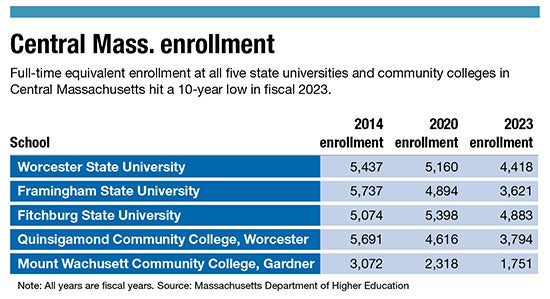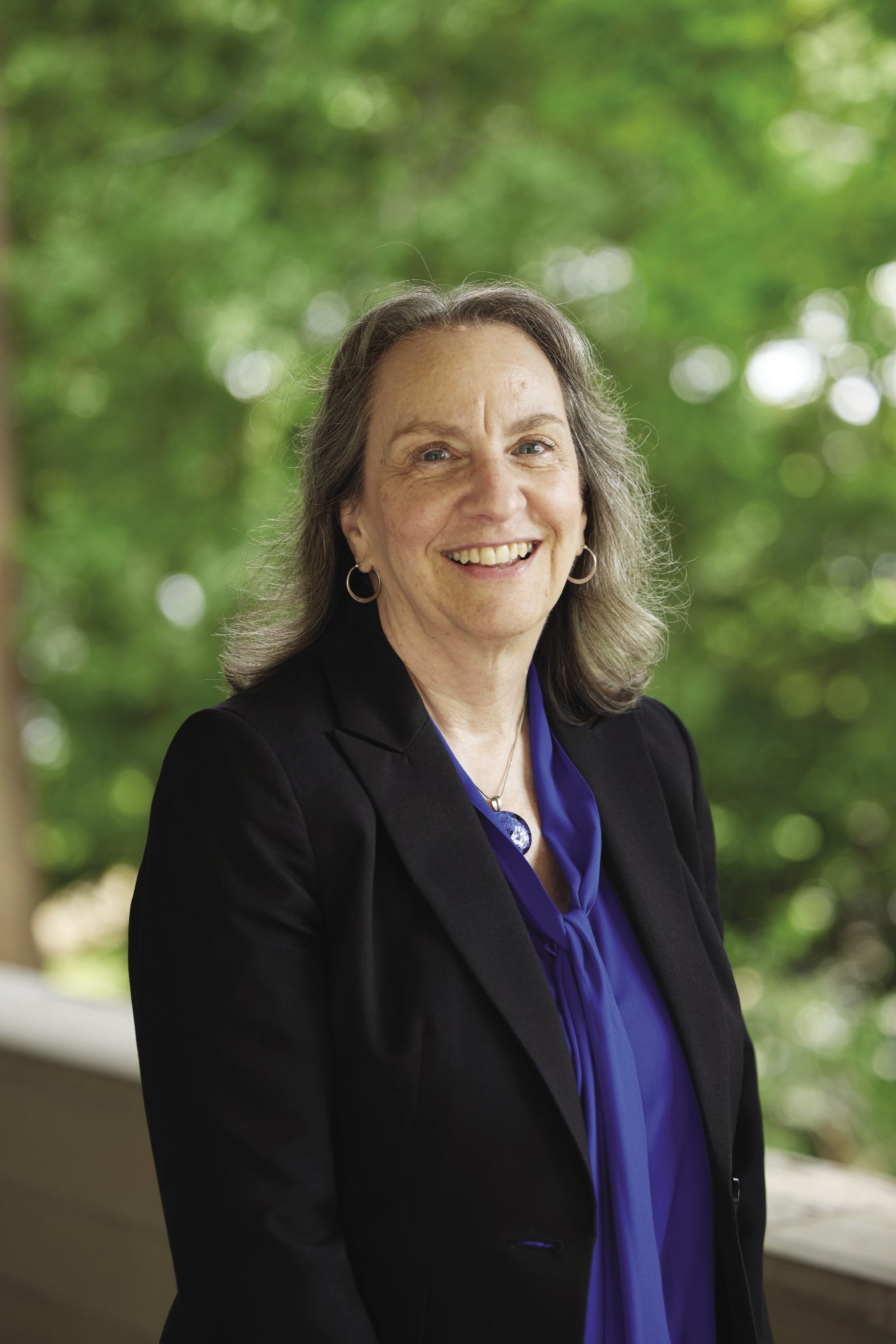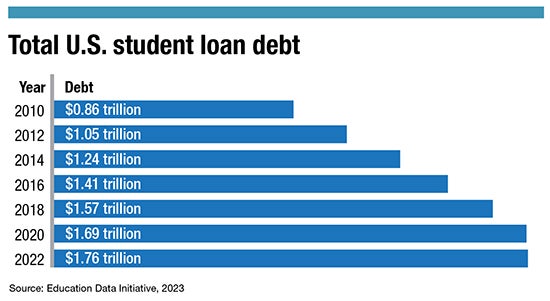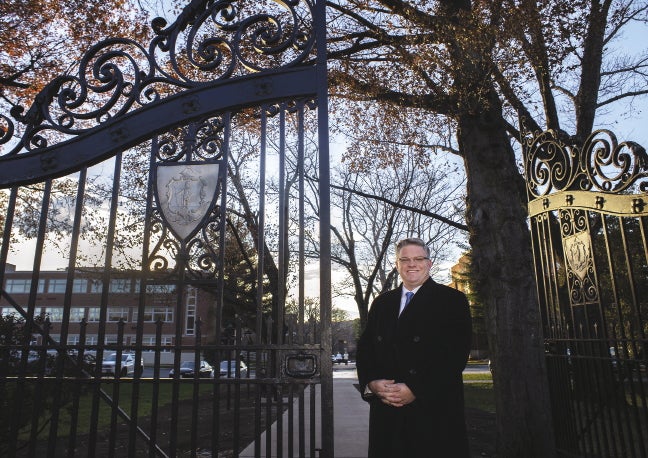Enrollment has hit a 10-year low at all five of the state universities and community colleges in Central Massachusetts, with a considerable drop between fiscal 2020 and fiscal 2023.
Get Instant Access to This Article
Subscribe to Worcester Business Journal and get immediate access to all of our subscriber-only content and much more.
- Critical Central Massachusetts business news updated daily.
- Immediate access to all subscriber-only content on our website.
- Bi-weekly print or digital editions of our award-winning publication.
- Special bonus issues like the WBJ Book of Lists.
- Exclusive ticket prize draws for our in-person events.
Click here to purchase a paywall bypass link for this article.
The November expansion of the MassGRANT Plus program by the Gov. Maura Healey Administration meant $62 million more dollars will be available to Massachusetts state college and community college students, covering tuition for approximately 25,000 students. The new funds will have a marked impact on the public colleges and universities in Central Massachusetts, and administrations are hopeful this level of funding will become permanent and change the landscape of higher education for publicly educated students.
Enrollment has hit a 10-year low at all five of the state universities and community colleges in Central Massachusetts, with a considerable drop between fiscal 2020 and fiscal 2023. If the new level of funding becomes permanent, Central Mass. higher education officials are hopeful more people will choose to attend college.
“We’re hearing from people saying they wanted to go to school years ago, and now they feel they actually can,” said Marcia Rosbury-Henne, associate vice president of enrollment management at Mount Wachusett Community College in Gardner.

Making college more accessible
The funds, which came from the millionaire’s tax, expand the eligibility population of students beyond those with family income below $40,000, who have traditionally accessed funds through the federal Pell Grant program.
At Worcester State University, a $3-million portion of the funding will impact approximately 1,000 students, said Ryan Forsythe, vice president of enrollment at WSU. This level of funding is historic, he said.
“It’s hard to ignore the significance of this moment. These are big dollars,” Forsythe said.
Students with family income under $100,000 will be eligible for elevated levels of funding for the first time.

This funding will hopefully make higher education seem more accessible for students from backgrounds of lesser financial means, said Iris Godes, Framingham State University dean of strategic enrollment management. Godes believes the funding, guaranteed for the 2023-2024 school year, will result in fewer students dropping out of college due to financial reasons.
“I hope we will see students be able to persist in college and persist in their degrees,” she said. The university does not have an accurate figure for the number of students who typically drop out due to financial reasons.
Both Worcester State and Framingham State in fiscal 2023 had their lowest levels of full-time equivalent enrollment in the 10-year span since fiscal 2014, when the Massachusetts Department of Higher Education has publicly available data on enrollment. Since fiscal 2020 when the coronavirus pandemic hit college enrollment hard, Worcester State saw its enrollment drop from 5,160 to 4,419, a drop of 14%.
Framingham State dropped from 4,894 to 3,621 (26% decrease) since fiscal 2020 while Fitchburg State University decreased from 5,398 to 4,883 (10% drop).
The additional financial resources could enable some students to transition from part-time to full-time enrollment, Godes said. Previously, part-time students were not eligible for MassGRANT or MassGRANT Plus funding, but they are under the expansion of the program.
The need for continued funding
However, the temporary nature of the funding makes it difficult to plan in the long-term. The $62 million is guaranteed only for the current academic year, impacting students currently enrolled in college, and is not guaranteed as a line in the state budget beyond this cycle.

It’s atypical to see this level of funding expansion in the midst of an academic year, said Denise Brindle, director of financial aid at Fitchburg State University.
Students who have already paid tuition and are now eligible to have it covered will be reimbursed. Some students may not have enrolled for the year, thinking the financial aspect was out of reach, she said. The limited term of the funding will pose some difficult decisions for students as they plan for a four-year academic degree without knowing what exactly the next year will bring in terms of funding, said Brindle.
The question the financial aid office at Fitchburg State and other universities now pose to the Office of Student Financial Assistance, part of the Massachusetts Department of Higher Education, is what can be expected going forward.
“We’ve said, ‘This is great. Can we count on it for our students for next year?’” said Brindle.
Still, Brindle sees no negative to the funding for this year.
At Worcester State, Forsythe is optimistic about the continuation of the funding into the next academic year and beyond.
“Any college or university that receives financial aid from the government knows that it is never guaranteed for more time that the legislature passes it for, but Massachusetts has a long history of funding financial aid for multiple years,” he said.

Broader implications
When funding is broadened, the university does see an impact on enrollment, Forsythe said, but it is soon to say what this expansion might change in terms of demographics.
It has made a large swath of formerly ineligible students open to aid, potentially putting higher education on the radar for some for the first time, said Godes.
“Any time that they expand funding for students, it is a good thing,” said Luis Pedraja, president of Quinsigamond Community College in Worcester.

It is exciting to see the state prioritizing making higher education more affordable, and thereby accessible, said Pedraja. The move has broader implications than just the financial landscape for higher education.
“If we are going to be competitive in attracting business and economic growth, we need to invest in our students,” said Pedraja.
As workforce needs expand, particularly following desired growth in the life sciences industry in Central Massachusetts and a planned continuation of similar developments, trained and educated talent will be at a premium. Enabling students to afford to gain that experience is essential, Pedraja said.
If Massachusetts is to be competitive in technology, biotechnology, and attracting and retaining businesses, this kind of investment in students and education is essential, he said.
For students, it’s a moment to take advantage of, Pedraja said.
“This is a great time to make your hopes and dreams of getting a degree happen,” said Pedraja.
Similarly to the state universities in Central Massachusetts, QCC and MWCC are at their lowest full-time equivalent enrollment points in the DOHE’s data dating back to fiscal 2014. QCC has enrollment of 3,794 in fiscal 2023, an 18% drop since fiscal 2020; and MWCC has enrollment of 1,751, a decrease of 24% since fiscal 2020.
Prospective students have already begun reaching out to Mount Wachusett, said Rosbury-Henne.
Students and potential students often equate financial aid with student debt, Rosbury-Henne said. She believes the funding will remove deterrents keeping students from applying or attending college.
“The cost of obtaining a post-secondary education, all over the country, but especially in Massachusetts, has been a privilege for so long. It’s been a privilege to apply for college even, let alone attend,” she said.
The funding will enable MWCC to help create a ripple effect extending beyond the educational institution, she said.
“Expanding aid will help Mount Wachusett positively impact the social and economic development in North Central Massachusetts for generations,” said Rosbury-Henne.

